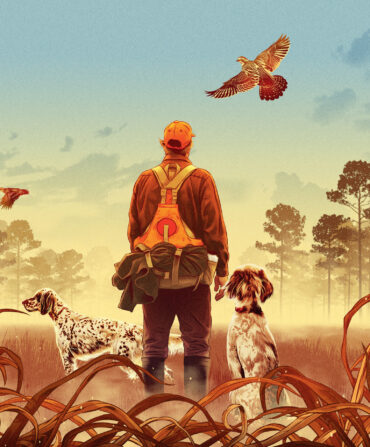Sporting
Born to Fly
At a grass airstrip in rural North Carolina, novelist and onetime fighter pilot Clyde Edgerton steps back into the cockpit—and back in time—for the flight of his dreams
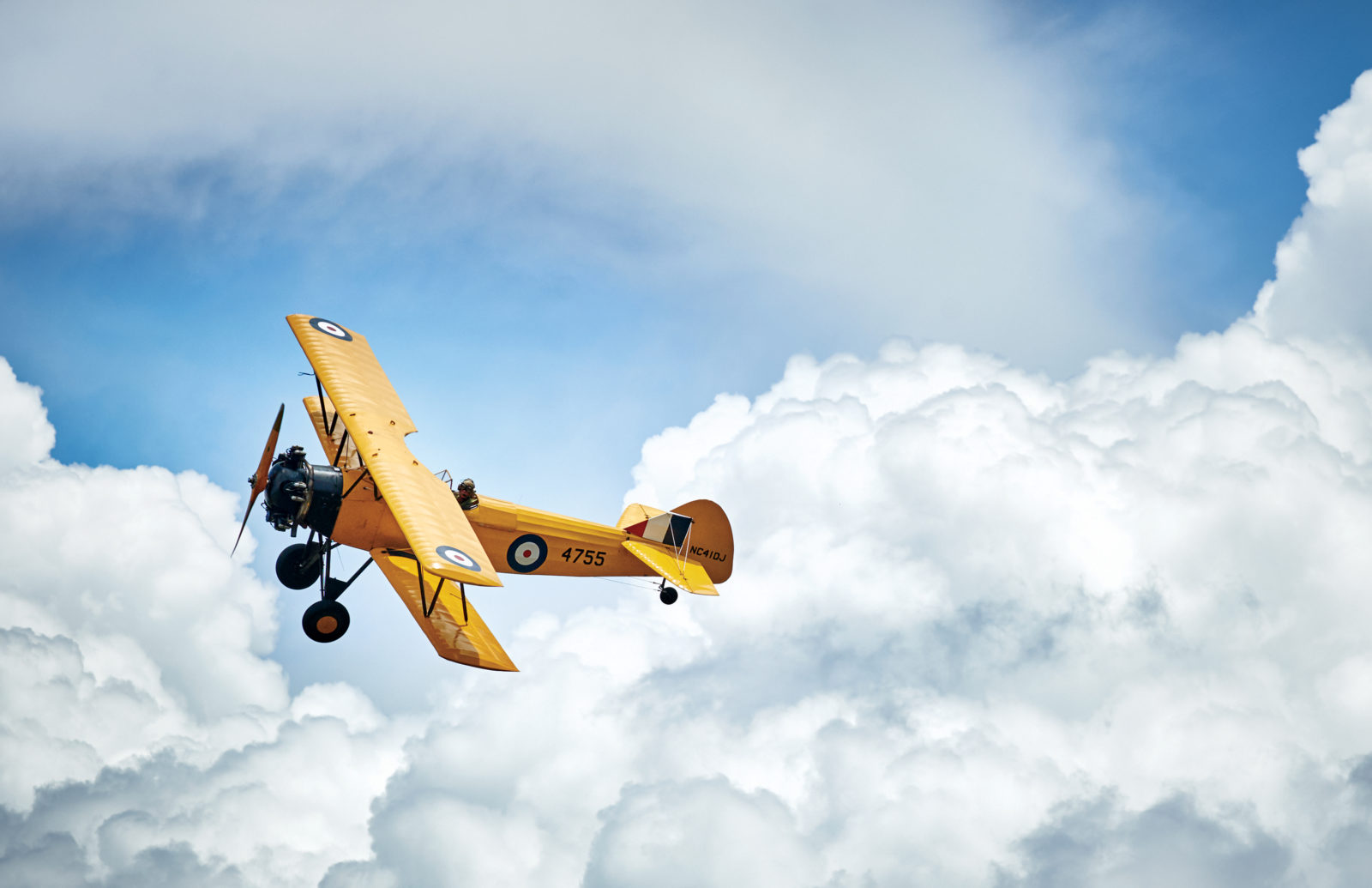
Photo: Thomas Hoeffgen
Pilot Phill “Butch” Bragg’s 1941 Fleet Finch biplane in the clouds above Windsor, North Carolina.
Just before I climb up and into the front seat, Phill Bragg, who goes by Butch—and will be in the backseat—says, “We need to go over the emergency procedures. If the engine quits, we will land somewhere.” He smiles. “That’s the only emergency procedure.” He’s being funny.
He’s not being funny when he says: “If we do make an emergency landing, don’t try to climb out before we come to a complete stop. With an open cockpit, people think it’s easy to get out, and bad injuries happen that way.”
The open front cockpit is about head high from where we stand beside the aircraft—with a wing above the cockpit, a wing below.
“The fuel tank,” Butch says, “is in the center of that upper wing, just above where your head will be.”
I think about a fire. I ask, “Does the aircraft have a name? Like Trudy?”
“It has a masculine gender. I just call it the Fleet.”
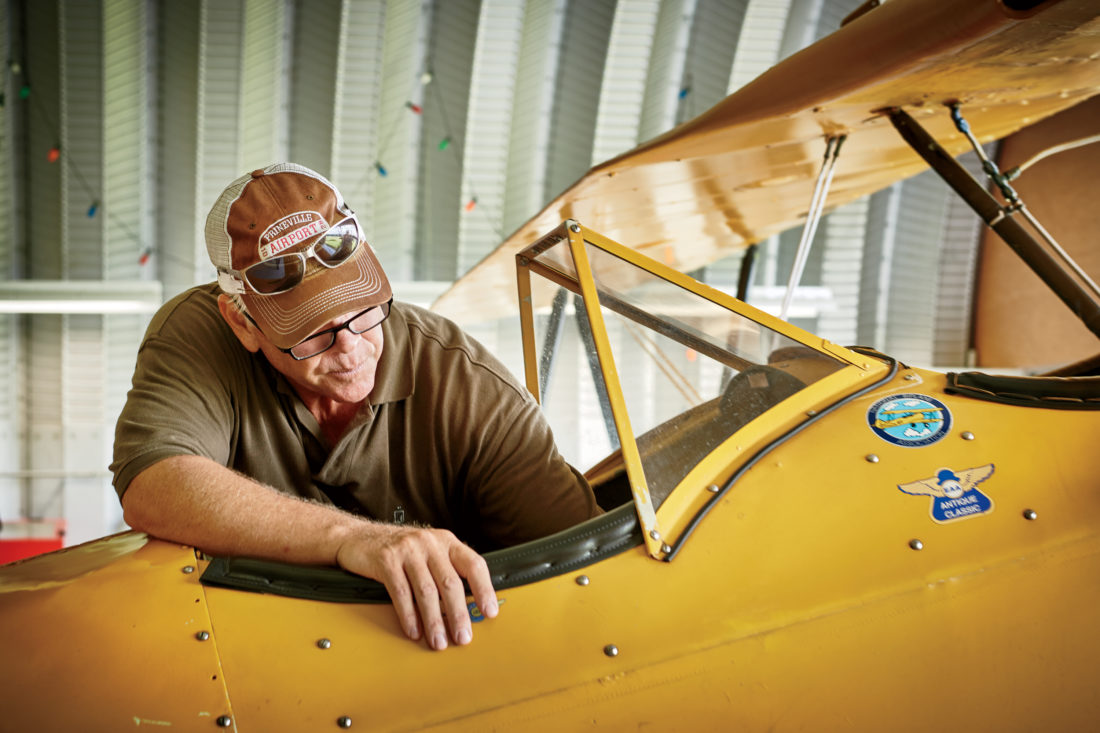
Photo: Thomas Hoeffgen
Bragg makes a few checks.
It’s a restored 1941 Fleet Finch, designed to train military pilots in Canada during World War II. During World War I, William Faulkner trained to fly a similar, but older aircraft in Toronto, hoping to be shipped to England to fight. But just as ground school was ending, the war ended, and it’s doubtful he ever got to fly. That didn’t stop him from claiming he crashed, inverted, into a hangar; and then later, down in Mississippi, walking with a cane, limping, he reportedly boasted that he’d been shot down in combat in Europe.
I step up onto the wing near the main body of the Fleet, place my foot onto the front cockpit seat, then work my way down and in. For me, a typical modern aircraft cockpit fits something like a dentist’s chair. This feels like loose and comfortable old clothes.
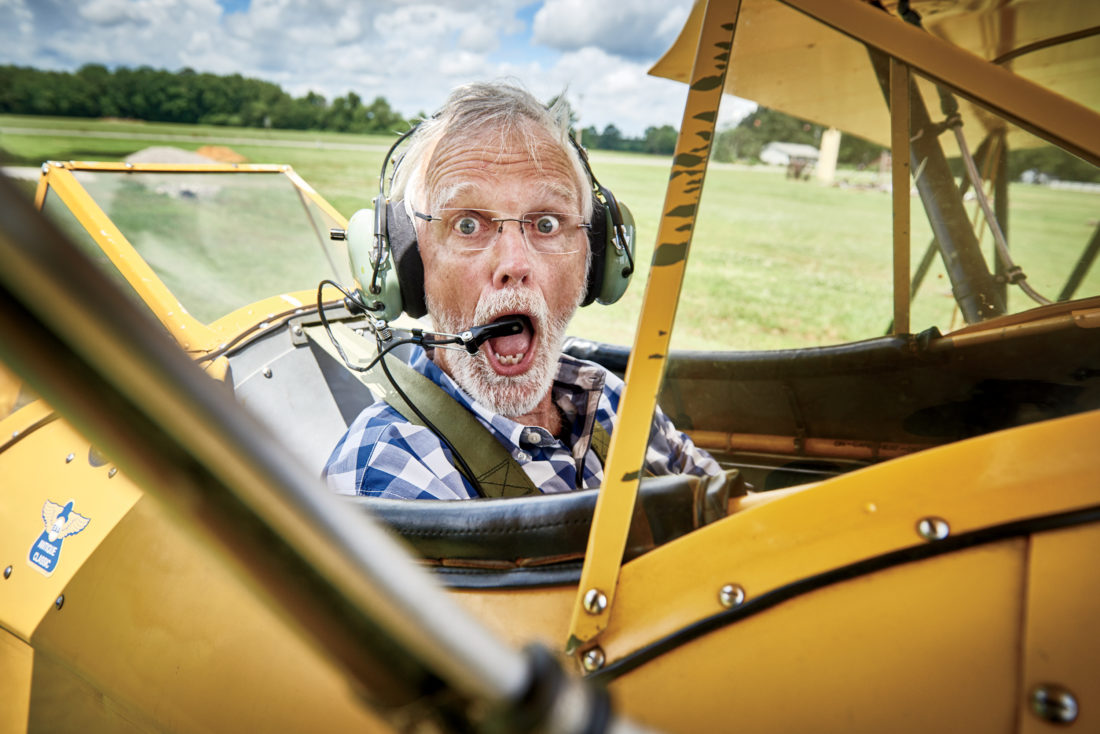
Photo: Thomas Hoeffgen
The author settles into the front cockpit before takeoff.
Each of the two cockpits has a set of flight controls: a stick up from the floorboard, directly in front of you—for turning the aircraft left or right, pulling the nose up or pushing it down; a throttle—a small handle against the left wall, pushed forward for thrust; a rudder pedal under each foot, to help with turns; and small brake pedals just inside each rudder pedal. That’s about it.
The instrument panel is a little more than an arm’s length in front of my chest. I’m pretty low down in the aircraft, my head sticking out above the fuselage, my face protected by a small glass windshield.
The Fleet’s instrument panel compared with a modern one is sort of like a cast-iron frying pan beside a large, full iPad screen. There in front of me are seven gauges—indicating airspeed, altitude, degree of turn, engine r.p.m., heading, oil pressure, and cylinder head temperature. The basics. You could fly without any of these, but that wouldn’t be smart.
Oh, I failed to mention: Butch once crashed an airplane. As did I. More on that later.
Butch, standing on the ground in front of the aircraft, prepares to hand crank the engine. I sit in the front cockpit, wearing a seat belt that at my waist hooks in with a shoulder harness. I remember that I am sitting in a military trainer—and that every military aircraft I flew as an Air Force pilot was equipped with a shoulder harness.
My feet are firmly placed on the two small brake pedals—to keep us stationary after Butch cranks the engine. You’ve probably seen a propeller hand cranked in old newsreel clips. Butch places his hands on the propeller and pulls down hard as he steps back to get out of the way. After several tries, the 160-horsepower engine “catches,” emitting a guttural, rough sound from some green meadow deep inside heaven. Something enchanting is happening, something that I’ll try to explain soon after we’re airborne.
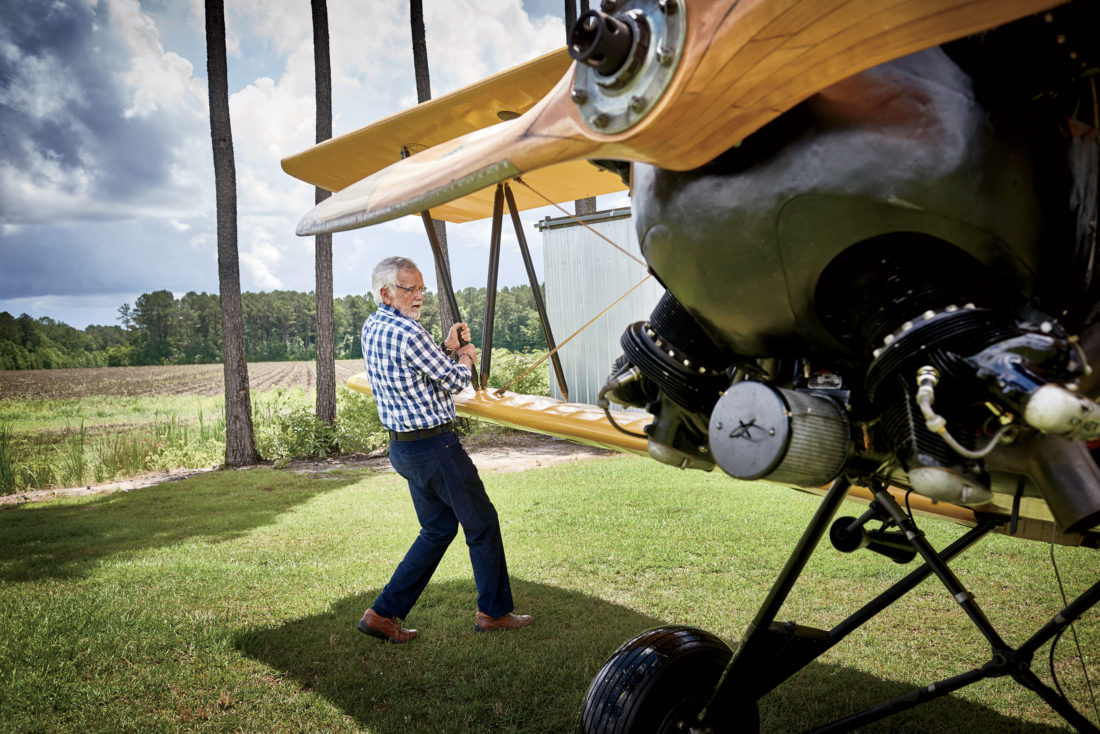
Photo: Thomas Hoeffgen
Readying the Fleet.
Butch straps into the rear cockpit, and I ask him through the intercom (we are wearing headphones with mics), “What’s the little barrel between my feet?”
“That’s the engine oil.”
My mind starts to again think about a fire but instead contemplates the color green—the green grass beneath the wheels and out along the grass runway, the green trees along the sides of the runway. A lot of rain has fallen lately, and the foliage looks rich. We taxi out and away from the hangar. Moving over grass in a small airplane is so much sweeter than scuttling along on hard asphalt.
Just before rolling onto the runway, we stop. Butch steps on the brakes, then runs up the engine for a few checks. Looks good, sounds good. We see no aircraft in the vicinity. We’re free to go.
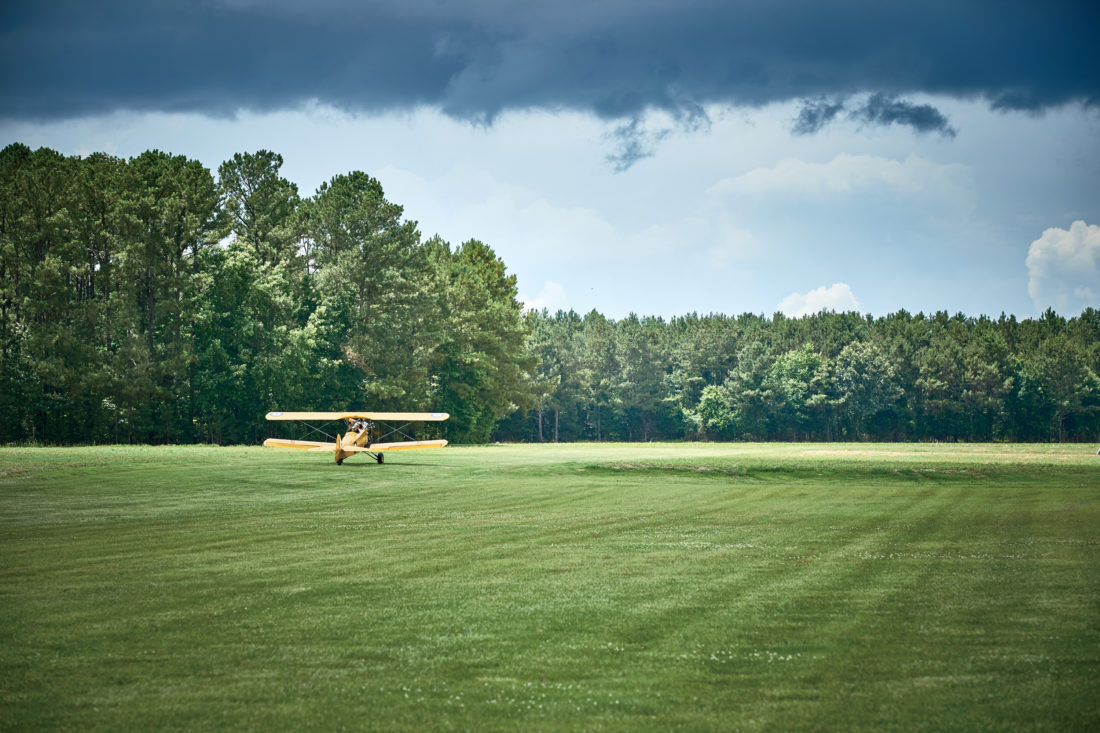
Photo: Thomas Hoeffgen
The grass runway.
In 2004, Butch was flying an Air Tractor AT-802 for the U.S. State Department, spraying coca fields in the tall, steep mountains of northern Colombia. He had just hopped over a ridge to search for more coca fields when he called a helicopter gunship that was escorting him. He said he had a problem. A report later written by the helicopter crew tells the story. The report describes his aircraft clipping palm trees in half, exploding on impact, and carving a four-hundred-foot swath down a mountainside before coming to rest in a pool of river water—leaving the forest and water on fire.
Just before the crash, Butch called, “Keep an eye on me, boys—this doesn’t look good.” When the rescue team got to the wreckage, Butch was standing three hundred feet up the side of a mountain, waving a destroyed survival radio. He remembers no part of the accident—before or after—other than swimming through flaming water. Cause of accident? Unknown. Injuries? A black eye, peeling skin from swimming in aviation fuel, and perhaps a concussion that led to amnesia.
I think most pilots can feel competence or incompetence in other pilots. I sense Butch’s expertise in spite of the accident. Besides that, and importantly, he is in his mid-fifties and has been flying since he was a teenager. There’s a saying: “There are old pilots, and there are bold pilots. But there are no old, bold pilots.”
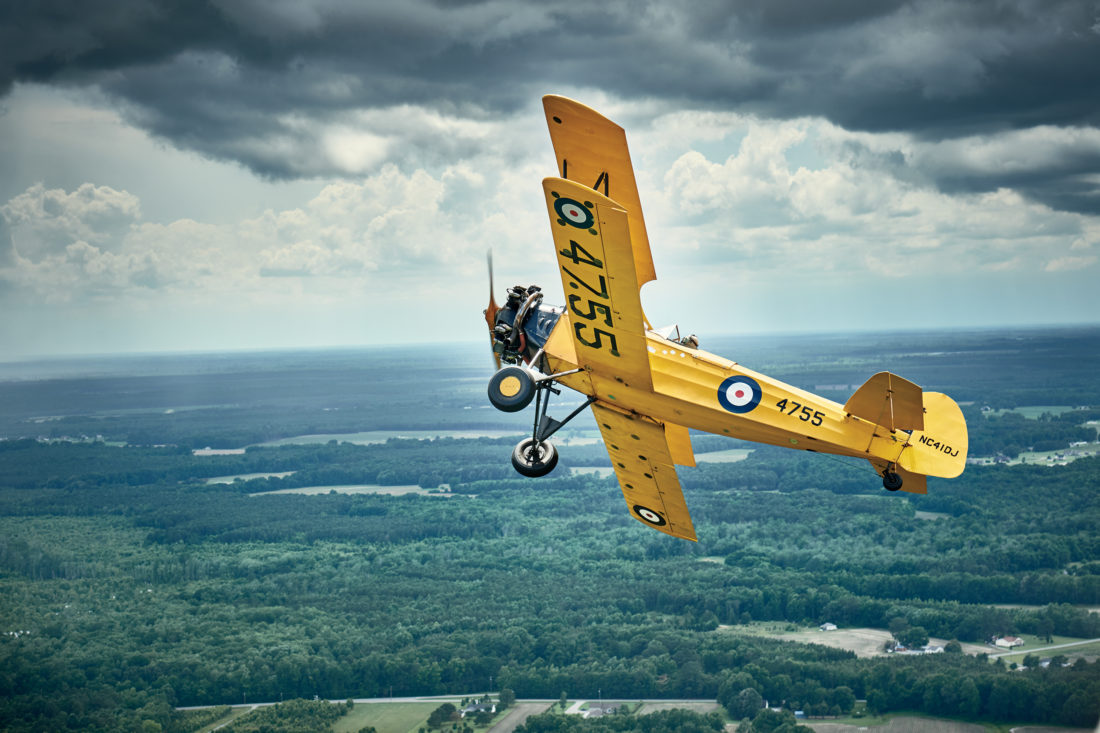
Photo: Thomas Hoeffgen
Enjoying the open air.
I first trusted Butch from afar—as a consequence of reading his two books about cross-country flying in the Fleet. Then I met him, watched, listened, and now trust him solid. Another reason I trust him is that when I told him that I didn’t want to take off or land today because I hadn’t been at the controls of an aircraft in a decade, he didn’t demur. He’s a flight instructor, a contract pilot who has flown many cool airplanes, and currently, he’s an aerial firefighter. He spends a couple of months each summer bombing West Coast wildfires, and then returns home to a roomy hangar in Windsor, North Carolina, that is the fantasy of any red-blooded aviator: It holds the Fleet and a wide array of tools, photos, and mementos, and behind a back wall are a lower and an upper room. In the lower room: a pool table; cases of books covering aviation, history, literature, and more; a bar; and a bathroom. Upstairs: a small bedroom. Butch lives with the Fleet.
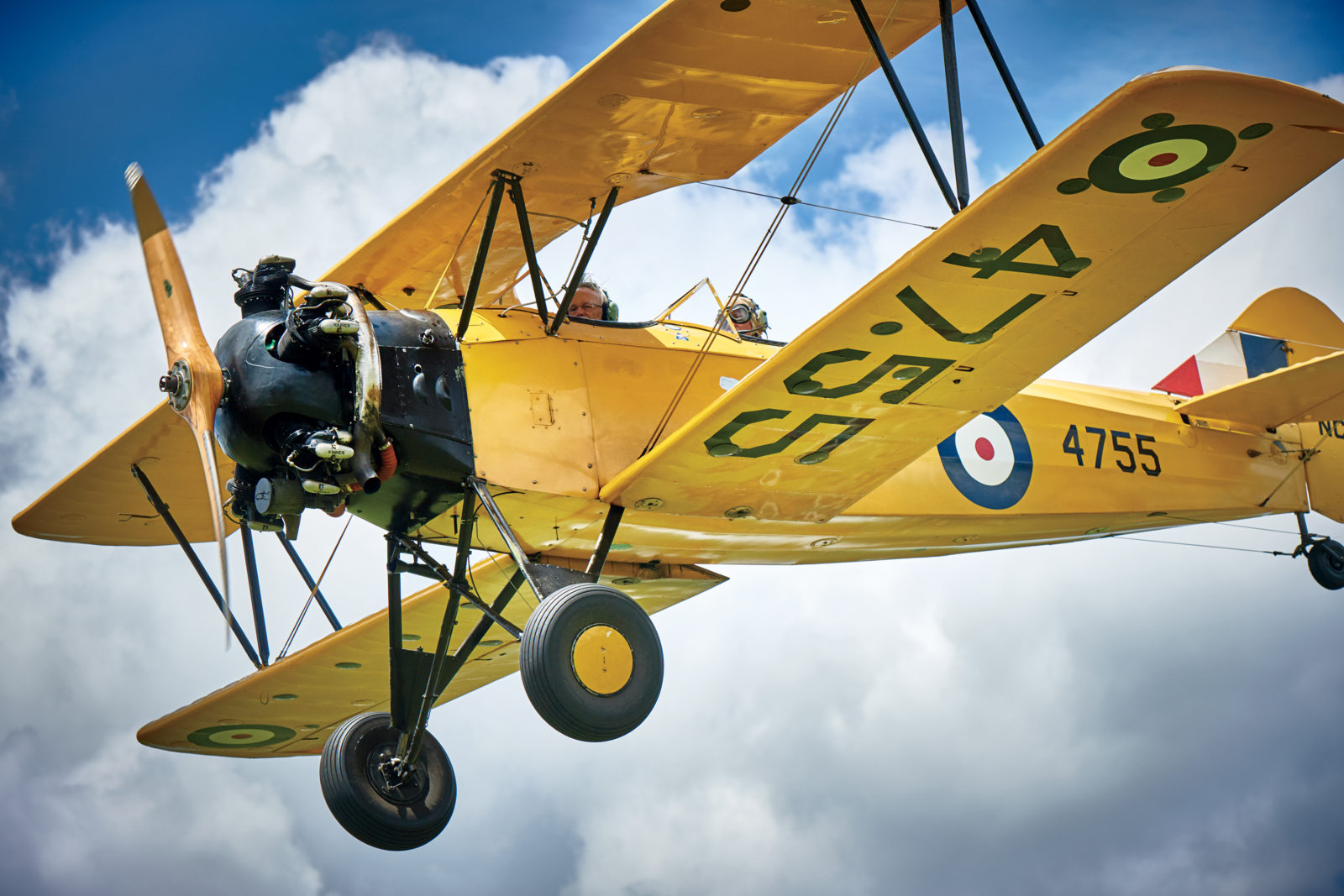
Photo: Thomas Hoeffgen
Edgerton (front) on the stick during his first flight in the Fleet, with Bragg in the rear cockpit.
My first dream of flying a biplane came to me about seventy years ago, in 1948, when I was four. I stood in my rural North Carolina backyard, heard a rumble in the sky, looked up, squinted my eyes, placed a hand against my forehead, and watched a biplane amble along. I wanted to be up there, doing that.
Soon, my mother, having noticed my fascination with airplanes—or just to expose me to the world—dressed me in shorts and a pressed shirt and drove me in our ’39 Ford to the Raleigh-Durham airport, which had just recently opened to commercial flight. Mother took pictures of me standing near airplanes. She walked with me out onto the flight line and asked a commercial pilot to show me inside the cockpit of his propeller-driven DC-3 airliner. He did.
My dream of being a pilot was planted.
Back then, had I been told that one day I’d pilot an aircraft at twice the speed of sound in one of the fastest jet fighters of its time, an F-4 Phantom, I’d have been astounded—or peed in my pants. My mother would probably have fainted with fear and stopped airfield photography and taken up my-son-at-church photography—at the Baptist church we attended five or six times a week.
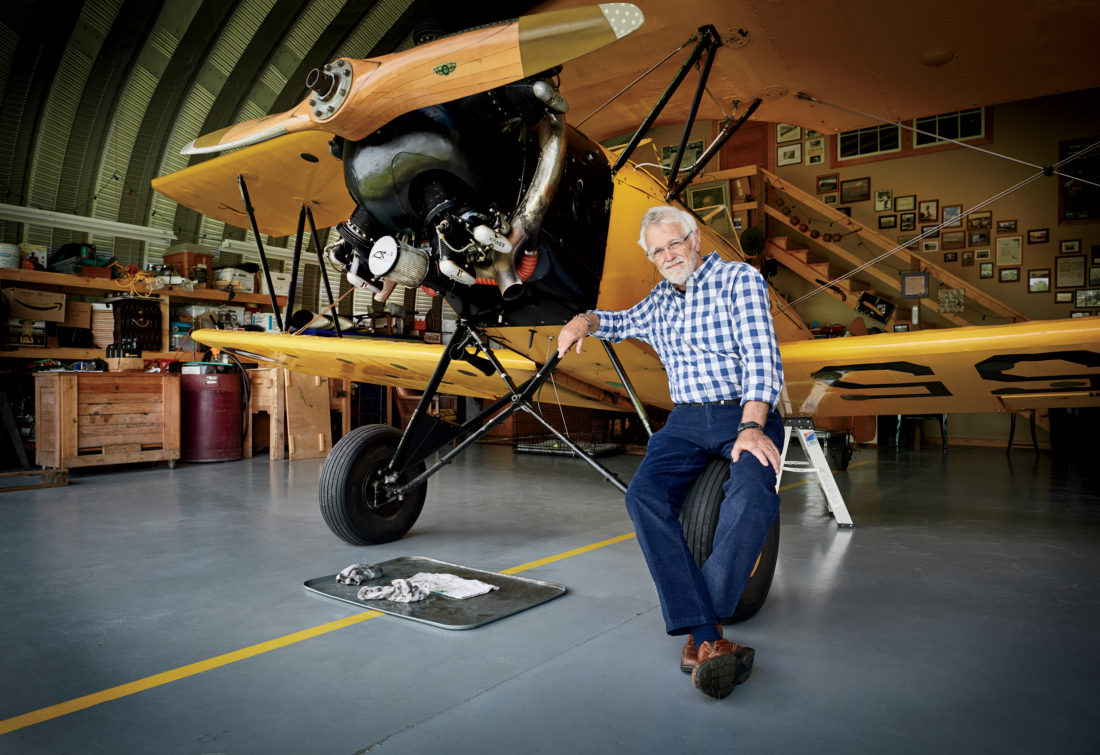
Photo: Thomas Hoeffgen
Edgerton with the Fleet in its home hangar.
In the fall of 1971, twenty-three years after squinting up into the sky as a small child, I completed a five-year stint as an Air Force pilot. Back home in North Carolina, I wanted to rest—after a year of combat flying in Southeast Asia—go to grad school, teach, and write fiction. I continued to fly off and on, but five years of flying fully acrobatic high-performance aircraft had spoiled me. There was no way I could afford such a plane. The airlines were hiring, but I wanted no part of flying a bus. I was strongly prejudiced against flying a vehicle with half a steering wheel (or yoke) and the throttle on the right (civilian aircraft, in general); I was only interested in flying with a stick, with the throttle on the left (acrobatic and military fighters, in general).
In the late seventies and early eighties, I lived in Apex, North Carolina, and there on many Sunday afternoons I noticed an old yellow Piper Cub lazily flying above. I asked around and soon found it based at a local airstrip. I walked up to it and looked into the cockpit. Up from the floor was a stick. Throttle on the left.
In the late eighties I bought a 1946 Piper Super Cruiser, an aircraft much like the Piper Cub. Though it had one wing, not two, and the cockpit was not open, the pilot sat alone, up front. I’d become used to such a setup as a fighter pilot. I named her Annabelle.
After two years of barnstorming with Annabelle around Eastern North Carolina, I crashed shortly after takeoff on a January morning in 1991. I was taking a friend up for some aerial photography. He was in the backseat; I was up front. Just after liftoff, I sensed that the engine was not delivering full power. Carefully, I put the aircraft back down, but the remaining runway was scant. Out beyond the end of the runway was a field of weeds that I’d walked before, looking for potholes or obstacles—in case what was now happening…ever happened.
But since my inspection of that field, a deep ditch had been dug perpendicular to my direction of movement. When the main gear dropped into the ditch, the rear of the aircraft looped over the front. The engine was no longer running, and my passenger and I were hanging upside down in our seat belts, not unlike a scene I had recently written about in a novel. In the fictional scene, gas leaks into the cockpit, and a cage of rattlesnakes has opened, leaving the snakes moving around below the heads of the hanging pilot and passengers. And there is smoke. The book was In Memory of Junior. (Nobody died in the crash—Junior had already died.)
A footnote: On the night of that crash, I called my friend the writer Tim McLaurin. I often took him on flights, and he gave me the idea for the fictional scene above. Tim was a daredevil of sorts who loved snakes and adventure. He died in 2002. And when I try to describe Tim’s view of life, I cite this exchange: When I told him I’d crashed, he didn’t ask if I’d been injured (only a head bump), or if my airplane was damaged (it was totaled). The first words out of his mouth were “Damn, I wish I’d been with you.”
Although I’ve flown in formation with other jets and been at the controls during:
full spins;
acrobatic maneuvers—loops, aileron rolls;
inverted level flight;
air-to-ground gunnery;
maneuvers at altitudes so high (52,000 feet) that an engine failed;
supersonic flight;
flight at 400 m.p.h. so low above water that I left a wake;
…my one remaining dream of flying is to simply pilot a vintage open-cockpit biplane, one like Snoopy flew in his dreams, one like Butch’s Fleet—one like I saw as a small child—the one we are about to take into the sky.
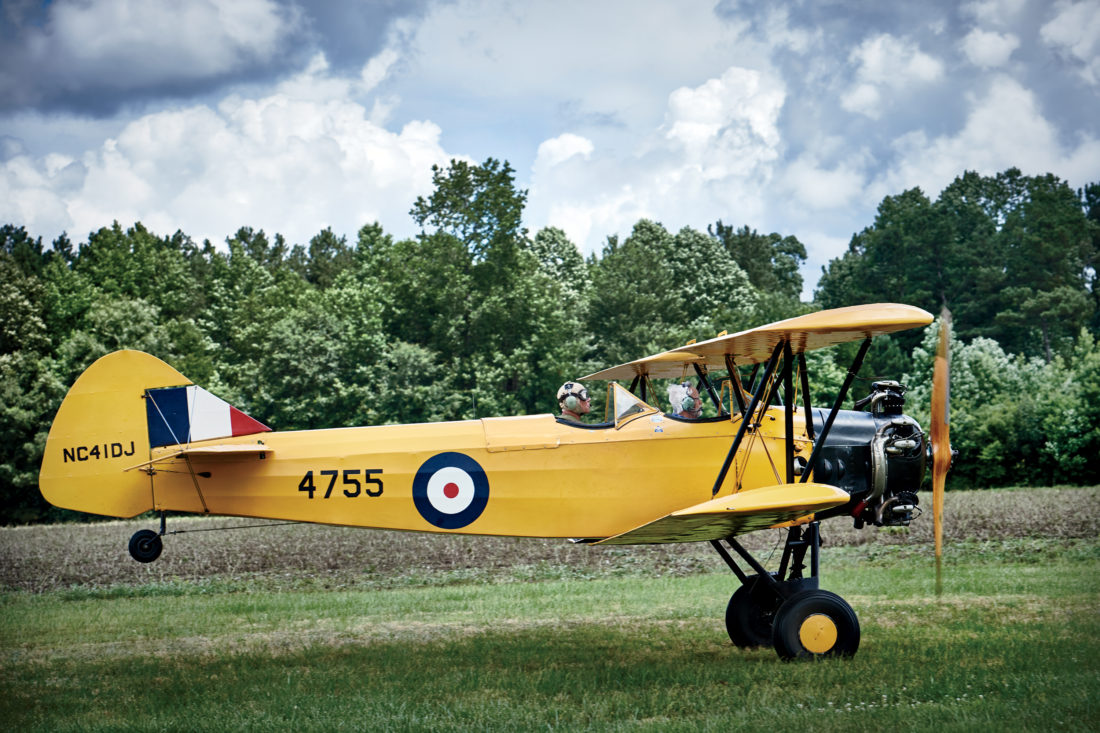
Photo: Thomas Hoeffgen
The Fleet on the runway.
We taxi onto and down to the end of the runway, turn 180 degrees, and start a slow roll. I’m a dandy Easterner about to become a cowboy. I’m a professor about to become an explorer. Will the old dream be more sublime than the impending reality? We move forward, lumber along a bit—slowly gain ground speed…and…then…
The earth no longer holds us.
At a few hundred feet up, Butch asks the question to which he knows the answer: “You want to fly it?”
“I have the aircraft,” I say. The stick is in my right hand, the throttle under my left, and the rudder pedals beneath my feet.
“You have the aircraft,” he says. (We can’t, after all, see each other’s hands.) I’m now going to try to tell you what this is like.
You get up in the morning, eat breakfast, get in a car, crank it, and go somewhere. There’s a starting point and an ending point. You move on a flat plane, as on a tabletop, from destination A, along paved roads, to destination B.
But now, piloting the Fleet, I own the world—it hangs from my finger on a thin silk thread. I am in a realm that frees me from a single flat plane. Theoretically, the number of geometric planes along which I can now move is infinite.
I look out through air, not through a window, and see a sea of rural North Carolina farmland and woods—out and away for miles and miles as if I’m atop a high mountain with no mountain below me. The old, slow, beautiful biplane grants me a feeling of gently hanging in the sky. It’s steady, rumbling smoothly.
“I’m going to get the feel of the controls,” I say.
“By all means.”
I turn left. The Fleet responds surely, comfortably. I level out, check my instruments—altitude, r.p.m. I turn right, trying to feel how much rudder I need. I look down. I level out and look straight up above me, then around in all directions. There is nobody else up here as far as I can see. I turn a little steeper than last time, look down again, and there is a slight take-up in my breath, the slightest tinge of a primal fear, a fear that, for me, brings not dread, but delight.
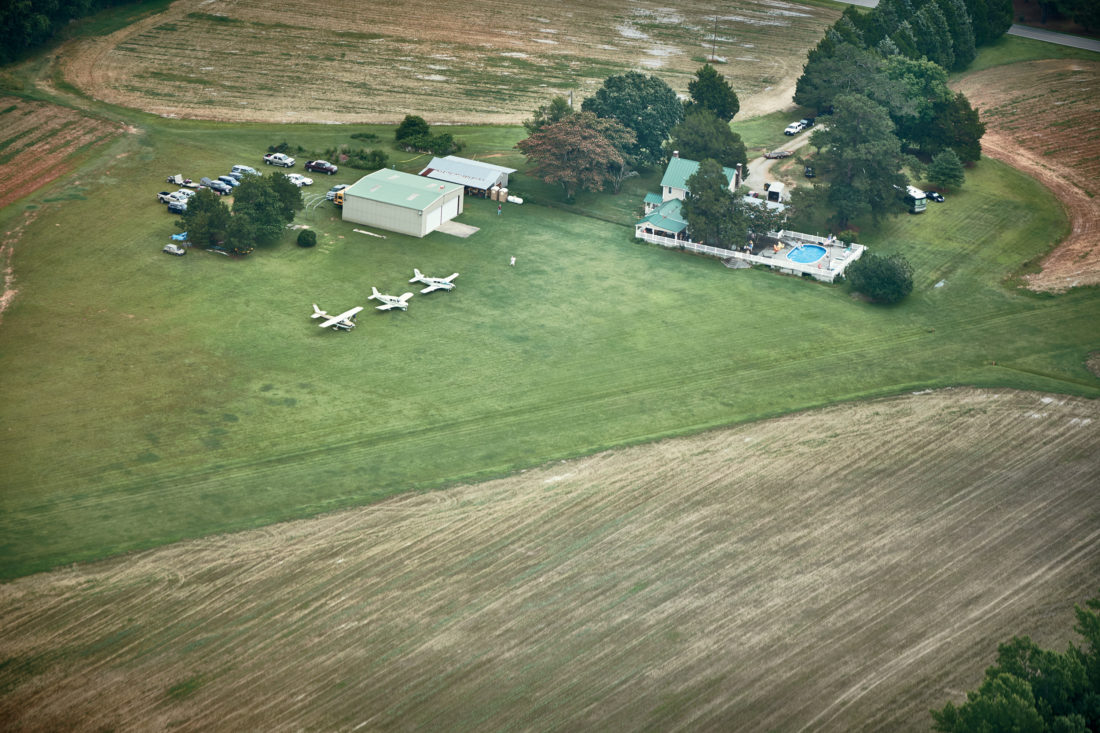
Photo: Thomas Hoeffgen
A few planes gather at a “fly-in” nearby.
Butch mentions a distant plume of smoke at one o’clock and tells me that’s the direction of our destination. I adjust power and check myself to see how precisely I can stay on heading and altitude.
Near our destination, Butch takes the controls. He’ll land. In a few hours, we’ll be headed back home and I’ll get to fly again.
We arrive over Dragonfly Field Airport—a private airfield behind the home of Butch’s friend Mike Spalding. Mike, like Butch, started flying in his teens and has flown more types of aircraft than most people have seen. He’s also an aircraft mechanic. His setup is not unlike Butch’s. A home, a hangar, a grass runway.
Butch enters the landing pattern, and on final approach he’s a tad high, so he “slips” the aircraft, descends and then intersects and follows an imaginary line that will take us to a touchdown in the right place—a smooth three-point landing. Landing on grass anywhere, but especially near somebody’s backyard, feels warmly satisfying.
We taxi in and park in line with a few other aircraft. The Fleet sits proudly, nose high, beside these more modern airplanes. Most of those will cruise at around 120 miles an hour. For the Fleet, that number is about 80. There’s nothing wrong with a hawk streaking toward prey. Likewise, there is nothing wrong with a buzzard, hanging lazily, drifting, moving slowly.
Today, Butch and I are buzzards.
Gathered on the deck behind Mike’s home and in his yard are pilots, their friends, families, and dogs, enjoying one another’s company. Fly-ins like this one occur every weekend—especially during summer weekends—at small airfields across the country.
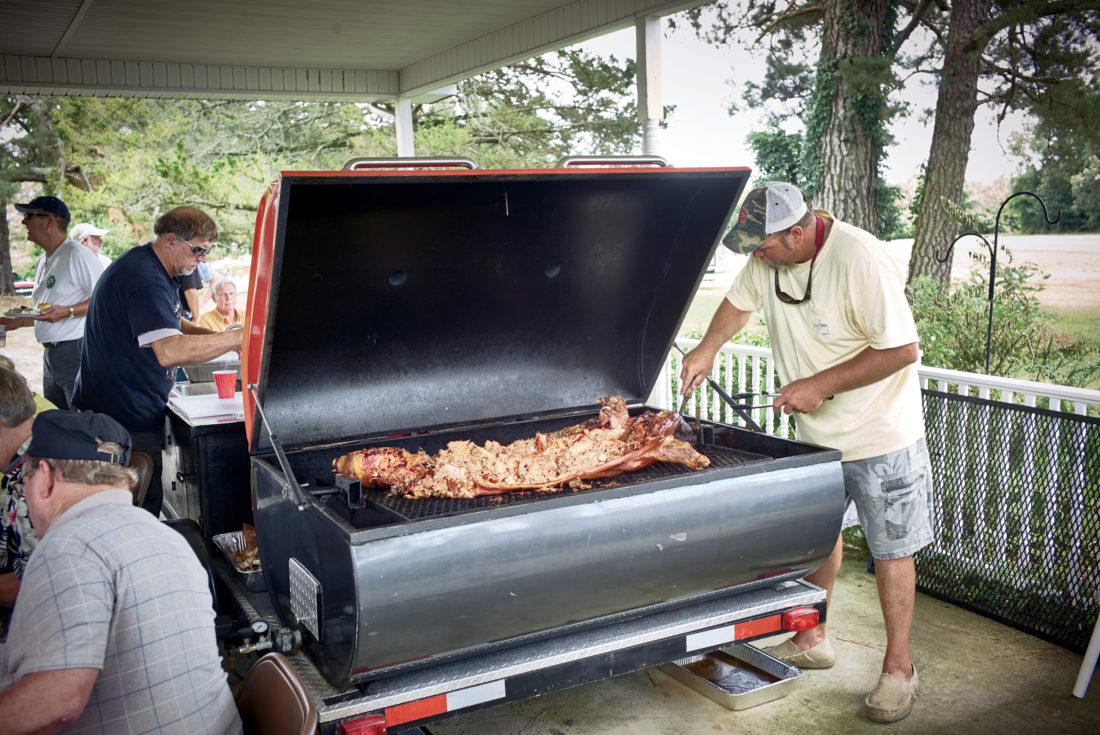
Photo: Thomas Hoeffgen
Pilots swap stories over barbecue.
I meet Bill Hood over delicious pork barbecue, sides, and an impressive bacon-broccoli salad. He tells me about his home-built aircraft and shows me a photo. It looks like a large, comfortable, sophisticated ultralight with a couple of engines. He spent over three years building it. He tells me that on many evenings, he and his wife fly over woods and fields near Kinston, North Carolina, to watch wild bears gather, eat, and play.
On the flight back, with the propeller about the length of two baseball bats in front of my face, the engine rumble-singing in my chest, the open air within reach—my nerves, muscles, and spirit meld with the Fleet.
We are one.
Large clouds billow nearby, and I see rain falling far, far away in slow-moving gray sheets. I have a minute to think about the origins of my early dream. As a child, I must have sensed that big clouds like we are now among were larger than trees and buildings…giant, soft pillows that I might one day be above or beside in an open-cockpit biplane rather than down below, standing on mere earth.
What’s that way down below? Ah. In the yard of a small house stands a four-year-old boy, hand to his forehead, squinting up at me.
He asks, “What’s it like?”
I say, “It’s wonderful, Bud. It even beats the dream.”
I try to think of a lesson or message to add, something I’ve learned over time. “And one day,” I say, “you’ll realize that an airplane, like many things, is more than an object.”



